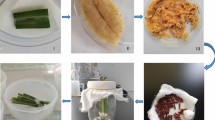Abstract
Moisture content, hardness or consistency, and age of diet were some of the properties studied for their effect on survival, growth and development of Sesamia inferens Walker. Survival of larvae was maximum on diet with 66.1% moisture. Increase or decrease in moisture resulted in excessive stickiness or dryness to the diet. Reduction in moisture content in the artificial diet was dependent on particle size of bulk constituent. Proper consistency or hardness resulting from 1.8 and 2.2% agar permitted higher number of larvae to reach pupal stage. Diet stored for 24 hr and 48 hr provided favourable conditions for the early instar larvae to establish on the diet.
Résumé
Les effects des teneuren eau, dureté ou consistance aussi qué l’⇌e de l’alimentation sur la croissance et développement de Sesamia inferens ont été étudiés. La survivance des larves était maximum au cas où la teneur d’eau de la diète était 66.1%. Quand la teneur d’eau est plus haut ou plus bas que cela, elle résulte en une diète trop adhésive ou trop sèche. Une réduetion de la teneur d’eau dans la diète synthétique (artificiella) était dependant sur la grosseur des particules de l’élément majeur. Une consistance propre résultant d’agar (1.8 to 2.2%) permet un plus grand nombre de larves à former des pupae. Une alimentation viellies pendant 24 h et 48 h donne des conditions favorables pour les larves de premier instar pour mieux s’etablir sur le régime.
Similar content being viewed by others
References
Chatterji S. M., Sharma G. C., Siddiqui K. H., Panwar V. P. S. and Young W. R. (1969) Laboratory rearing of the pink stem borer, Sesamia inferens Wlk. on artificial diet. Indian J. Ent. 31(1), 75–77.
Chippendale G. M. (1970) Development of artificial diet for rearing angumois grain moth. J. econ. Ent. 63, 844–848.
Chippendale G. M. (1971) Observations on the physical and chemical composition of diets of the angumois grain moth, J. Insect Physiol. 17, 1257–1266.
Hensley S. D. and Hammond A. M. Jr. (1969) Laboratory techniques for rearing the sugarcane borer on an artificial diet. J. econ. Ent. 61, 1742–1743.
Kamano S. (1971) Studies on artificial diets of the rice stem-borer Chilo suppressalis Walker. Bull. nat. Inst. Agric. Sci. Ser. C. 25, 1–43.
Lingappa S. (1978) Development of artificial diet for mass rearing Sesamia inferens Walker (Lepidoptera: Noctuidae) and screening for resistance in finger millet germ-plasm. Ph.D. thesis, University of Agricultural Sciences, Bangalore, India.
Lingappa S. and ChannaBasavanna G. P. (1981) An artificial oviposition device for the pink stem borer, Sesamia inferens (Lepidoptera: Noctuidae). Colemania 58, 47–51.
Miskimen G. W. (1965) Nonaseptic laboratory rearing of the sugarcane borer Diatraea saccharalis. Ann. ent. Soc. Am. 58, 820–833.
Qureshi Z. A., Anwar, M., Ashraf, M., Chata N. V. and Arif M. D. (1972) Rearing, biology and sterilization of the pink rice borer, Sesamia inferens Walker. Jap. Pestic. Inf. 10, 129.
Siddiqui K. H. and Chatterji S. M. (1972) Laboratory rearing of the maize stem borer Chilo zonellus (Swinhoé) (Crambidae: Lepidoptera) on a semi-synthetic diet using indigenous ingredients. Indian J. Ent. 34, 183–185.
Sinoir Y. (1968) Etude de quelques factaurs conditionnant la prise de nourriture chez les larves du criquet migrateur, Locusta migraloria migratoriodes F. et R. (Orthoptera: Acrididae), I Facteures externs. Ent. exp. appl. 11, 195–210.
Solomon J. D. (1966) Artificial rearing of carpenter worm, Prionoxystus robinae Pesk. (Lepidoptera: Cassidae) and observations of its development. Ann. ent. Soc. Am. 59, 1197–1200.
Tanton M. T. (1965) Agar and chemostimulant concentrations and their effects on intake of synthetic food by larvae of the mustard beetle Phaedon cochleariae Fab. Ent. exp. appl. 8, 74–82.
Toba H. H., Kishaba A. N. and Pangaldan R. (1970) A rating system for evaluating the suitability of larval diets for cabbage loopers. J. econ. Ent. 63, 759–760.
Venderzant E. S. (1969) Physical aspects of artificial diets. In Insect and host plant. (Edited by Wilder J. de and Sachoonhoven L. M.) Proc. 2nd Int. symp., Wageningen, The Netherlands, 2–5 June, 1969: 642: 650.
Venderzant E. S. and Reiser R. (1956) Studies of the nutrition of the pink bollworm using purified case in media. J. econ. Ent. 49, 454–458.
Walker D. W., Alemany, A., Quintana, V., Padovani F. and Hagen K. S. (1966) Improved xenic diets for rearing sugarcane borer in Puerto Rico. J. econ. Ent. 59, 1–4.
Author information
Authors and Affiliations
Rights and permissions
About this article
Cite this article
Lingappa, S. Importance of Physical Properties of Artificial Diet for the Pink Stem Borer, Sesamia inferens Walker. Int J Trop Insect Sci 8, 65–69 (1987). https://doi.org/10.1017/S1742758400006986
Received:
Revised:
Published:
Issue Date:
DOI: https://doi.org/10.1017/S1742758400006986




